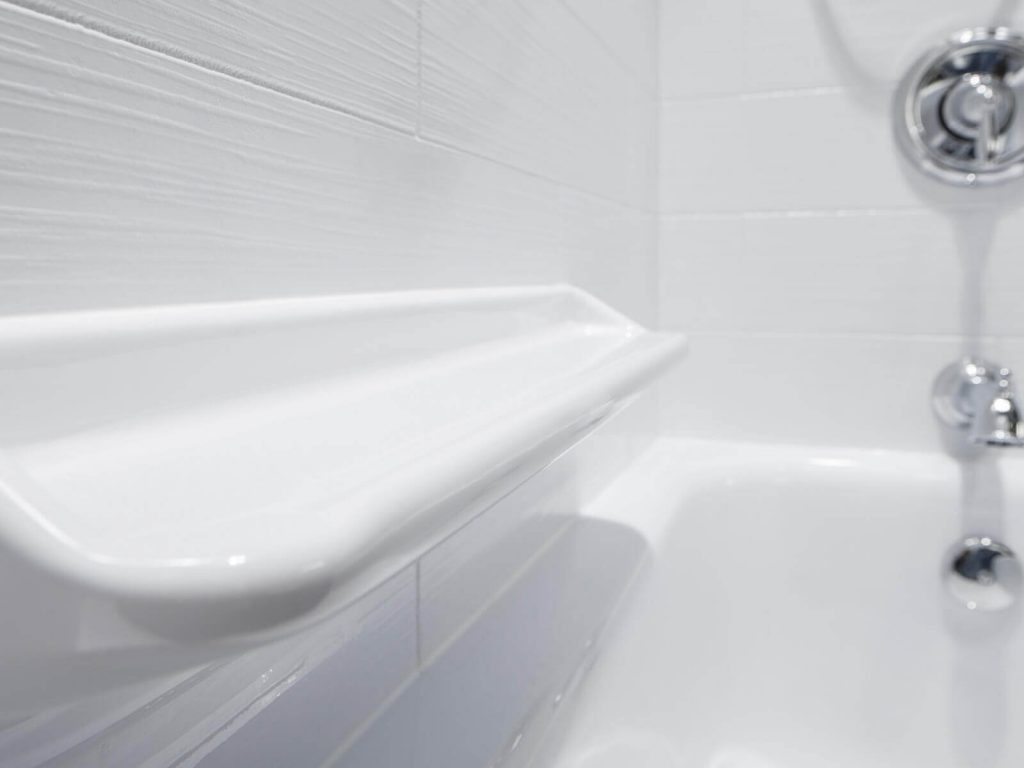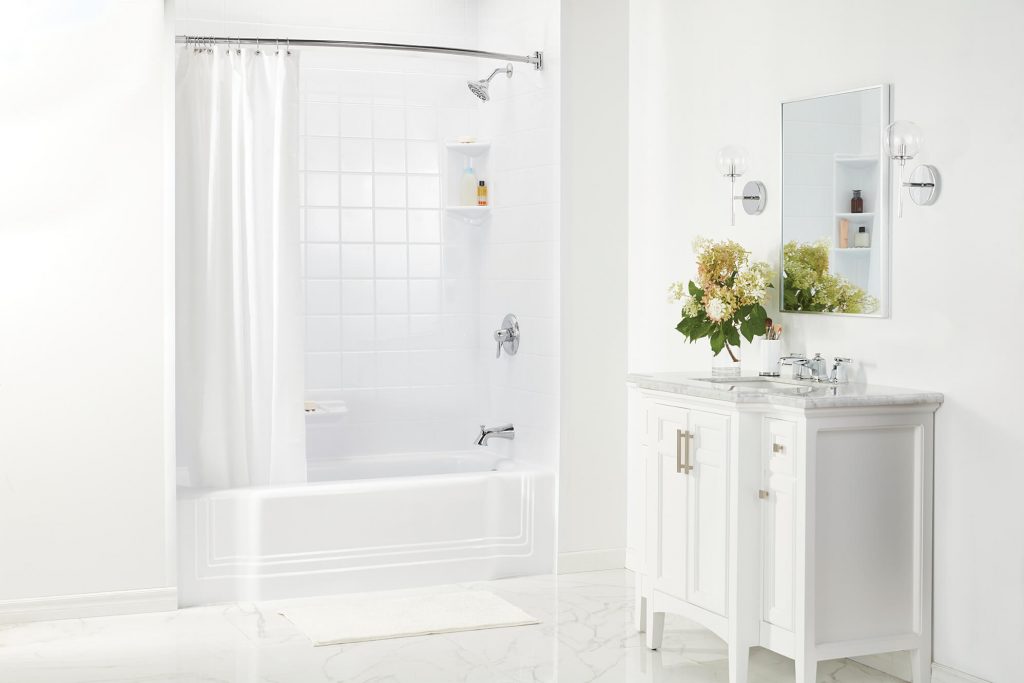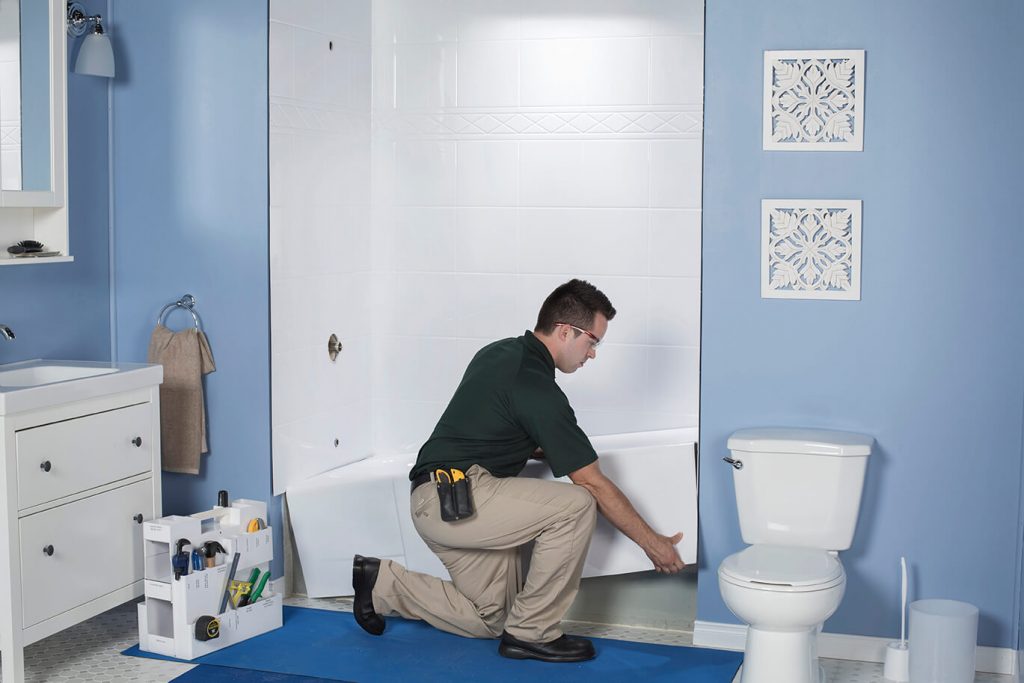When starting any home remodel project, it is best to have a plan. Thinking about your goals for the project and what you want to improve, get rid of, or add, can help make the decision-making process more manageable. A plan also ensures that you’ll stay on track and keep the big picture in mind.
We’ve put together this step-by-step bathroom renovation guide to help you organize the design and completion of your project so you can have a less stressful experience. First, we’ll look at a list of steps you can take to plan your bathroom remodel. Then we’ll answer some questions like how long it can take and how much it could add to the value of your home. Finally, we’ve included a bathroom remodel checklist to help keep you on track.
How to Plan a Bathroom Remodel

Bathroom remodels vary in complexity, from a simple refresh to a complete renovation. No matter how extensive your project, there are some steps you can take ahead of time to help ensure your project will be a success.
1. Gather ideas
The first step is to decide how you want your bathroom to look when the project is complete. These days there are many places to look for bathroom design ideas. The internet and social media are full of beautiful photos of fantastic bathroom ideas that you can use to inspire your project. Pinterest is an excellent social media site to get and keep design ideas. You can browse for bathroom remodels and find hundreds to choose from. Or, if you’re looking for a specific feature, like a vanity, you can search and find lots of inspiration.
Online design sites let you see your design ideas come to life in the virtual world. You get to choose different finishes and colors and see how they would look in your space. This is a great way to see a lot of options in a short amount of time.
For some items, like faucets and fixtures, you’ll probably want to see them in person and test them out. A visit to the local home improvement store is a great way to spend a Saturday. Many of them have sinks and bathtubs set up so you can fully experience how they’ll feel in your home. Be sure to take photos of any fixtures that catch your eye, so you’ll have a record. Gather paint chips and other finish samples while you’re there.
Store your idea photos in a central location on your computer, tablet, or phone. You can even save them to a cloud storage site, so you have access to them wherever you are. Keeping your ideas in one place will help you make the final decisions on your design when it comes time. Organize your photos by area of the bathroom, or design style, or whatever makes the most sense for you.
2. Decide what needs to be changed or added

Next, you’ll need to decide the scope of your project. Will you be gutting the bathroom and starting over, or just changing a few fixtures and adding a coat of paint? The amount of work you decide to do will affect your project’s budget, as well as how long it takes to complete.
We often don’t realize how many fixtures and accessories there are in a bathroom. Here’s a list of items you may want to consider changing during your project:


- Bathtub/spa
- Shower
- Shower door or curtain
- Soap holder/shelving
- Cabinets/shelves
- Countertops
- Vanities
- Lavatory and faucet
- Grab bars
- Lighting
- Medicine cabinet
- Tub/shower faucet, valve, and drain
- Mirrors
- Shower seats
- Adding walls
- Soap and lotion dispensers
- Wallcoverings (paint, tile, wallpaper)
- Flooring
- Toilet paper and towel holders
- Ventilation (exhaust fan)
- Heating and air conditioning
There’s a lot to consider when deciding to make a change. Use the checklist above to determine what you want to remove, replace, or add to your new bathroom.
3. Decide whether to do it yourself or hire a contractor
If your family, friends, or you have any carpentry or renovation skills, you may decide to complete your bathroom renovation as a DIY project. It can be less expensive to perform the work yourself, but it may not be worth it. The project could be dangerous, require specialized knowledge (like code requirements), or could do severe damage to your home if it isn’t done right. It’s best to hire a professional.
Some of the work involved in a remodel project, like plumbing, electrical, and HVAC is best left to the professionals. They have the skill and knowledge to ensure that the work is done correctly, per local codes, and that it is done safely. They have years of education and professional experience, as well as the right tools for the job. You’ll save time and money when you have a professional perform the work. For example, if you’re thinking of changing out your tub or shower, Bath Fitter® can do the work for you in as little as one day and guarantee their work.
Other portions of the project, like painting and flooring, can be performed by a homeowner for significantly less money than a contractor would charge. Although you should be realistic in estimating how long a project will take you and have the necessary skill set to complete the project to your expectations. Sometimes it’s easier to hire someone to help you in areas outside of your expertise.
If you decide to do all or part of your bathroom remodel DIY, be careful that you don’t get in over your head and take on more than you can handle. Make sure you have additional help available for heavy tasks like installing a new bathtub or shower. These fixtures can be very heavy, and you want to protect yourself from potential injury.
How to select a contractor

Finding the best contractor for your project takes a bit of research. Most states require contractors to be licensed, which helps ensure that they have the proper insurance and bonds to protect you if something goes wrong during your project. If you find a contractor you’d like to use, be sure to check your state’s contractor licensing website to make sure the company is registered.
Other things to look for when selecting a contractor include:
- 1
Recommendations, reviews, and customer feedback
Ask your neighbors or friends if they can recommend a contractor. Check review sites and a company’s website for additional feedback. One negative review doesn’t mean that a contractor isn’t good. Several negative reviews may indicate a company you should stay away from. Another good source to check is the <a href=”http://www.bbb.org/” target=”_blank” rel=”noreferrer noopener”>Better Business Bureau (BBB)</a>. They rate businesses based on the number of complaints and how long they’ve been in business.
- 2
Quality of work
Quality can be hard to judge when you cannot see the work in person. Most contractors have photos of their work on their website or social media accounts, so you have an idea of the work they perform. Reading reviews online may give you a better idea of their quality, at least if there were any problems with past jobs. If possible, visit a project that is in progress so you can see what the contractor’s work looks like with your own eyes.
- 3
Length of time in business
Companies that have been around for longer and are established in the community are generally more stable than newer companies. This doesn’t mean a young company won’t do good work. Although, you have more assurance that the company will be around to address warranty issues if they’ve been in business for a while.
- 4
Responsiveness
Once you contact a contractor, track how long it takes to get a response. Some contractors are prompt with their follow-up, and some are so busy they don’t have time to follow up on new work. You want a contractor that will be responsive not only before the sale but after as well.
4. Establish a budget

Based on the work you’ve chosen, the types of fixtures and finishes, and whether you’re doing the work yourself or hiring a contractor, you should be able to establish a budget for the project now. Contractors can quickly provide pricing on their portion of the work, or you can hire a general contractor to provide a bid for the whole thing. Make sure to include the following in your budget:
- Cost of materials and supplies (tools, adhesives, application supplies)
- Cost of any contractors or workers hired
- Design and permit costs
- Cost of lost income if you must take time off from work
- Inspection costs or fees
Contractor pricing will include purchasing the materials needed for your project, as well as installing them. In addition, they can provide a warranty on all work they install. The peace of mind in knowing that the project will be taken care of and backed by the company that installed it can make the additional cost well worth it.
After reviewing your contractor’s estimate, you may find that you must adjust your design ideas. Ask your contractor if they have suggestions to help you meet your budget needs. They often have innovative ways to help their customers save money. You can also look at more economical finishing materials and fixtures to help cut costs.
5. Order materials
Once you’ve selected your materials, established your budget, and decided who will do the work, you can start to order the materials you need for your remodel project. Some materials and fixtures may have longer lead times, so you’ll need to order them weeks before you need them, especially if you choose custom design options.
6. Complete your design and pull permits
Depending on what type of work you include in your project, you may need to pull building permits before you start your project. A contractor can consult with you on what work needs to be permitted and what doesn’t. Some permits can be purchased over the counter and don’t require submitting drawings or plans. However, suppose your project is complicated and involves things like adding or removing walls. In that case, you may have to submit plans to your local jurisdiction for review before you can start your project. Plan review times will vary depending on how busy the jurisdiction is. The contractor should be able to work with an architect or designer to provide the drawings you need.
How long does it take to complete a bathroom remodel?
The amount of time it will take to complete a bathroom remodel project will vary depending on the amount and type of work included in the project. An extensive demolition and renovation project may take months, while if you’re changing out bathroom fixtures and adding paint, you may be able to complete it in a few days.
Besides the type of work, the lead time for fixtures and materials determines how long a project will take. If the flooring is a custom-made tile that takes ten weeks to produce, then the schedule must include that time. The work on-site can often be delayed until just before materials are available, meaning that your life won’t be interrupted for as long.
Due to the nature of the room being renovated, hidden damage can be an issue that can also extend a project’s schedule. The project schedule should include additional time for unforeseen problems or repairs that may be needed as the work progresses.
How much does a bathroom remodel add to the value of a house?
According to the National Association of the Remodeling Industry (NARI) 2019 Remodeling Impact Report, created in joint partnership with the National Association of Realtors (NAR), bathroom remodels are fifth on the list of most appealing projects from a buyer’s perspective. Realtors also listed them fifth on their list of projects most likely to increase a home’s value.
The same report said that homeowners could expect to recoup 57% of the cost of a bathroom project if they sell their home. That percentage is based on remodeling contractors’ estimates of the cost of a project and realtors’ estimates of the dollar amount that could be added to the sale price.
How much does a bathroom remodel cost on average?

According to HomeAdvisor, the average cost of a bathroom remodel project is $10,753. Homeowners usually spend from $6,127 to $15,383 on their projects. You can expect to spend as little as $3,500 to $7,000 updating a small or medium-sized bathroom or spend $25,000 plus on a large or master bathroom.
Factors that may influence the cost of your project include:
- Bathroom size and number of fixtures
- Quality of materials
- Types of fixtures, appliances, flooring, and counters
- Regional labor pricing differences
- Unnecessary markups on material and labor
- Changing the floor plan or size of the bathroom
TIP:
If your bathroom project touches a few hands, you can bet there are markups along the way, both on material and labor.
Working with reputable companies that own their process and guarantee their product, like Bath Fitter®, can be advantageous on many levels.

Plan for a successful bathroom remodel
Before you begin a large project like a bathroom remodel, having a plan will help you stay organized and on track. There will be fewer surprises, and you’ll feel confident that you’ve got a solid plan to complete the work.
Use the above bathroom remodel checklist to help you organize your ideas, decide what you want to change or add to your bathroom, decide whether to hire a contractor, establish a budget, and make the final design decisions. Soon, you’ll be enjoying your new bathroom.

Leave a Reply